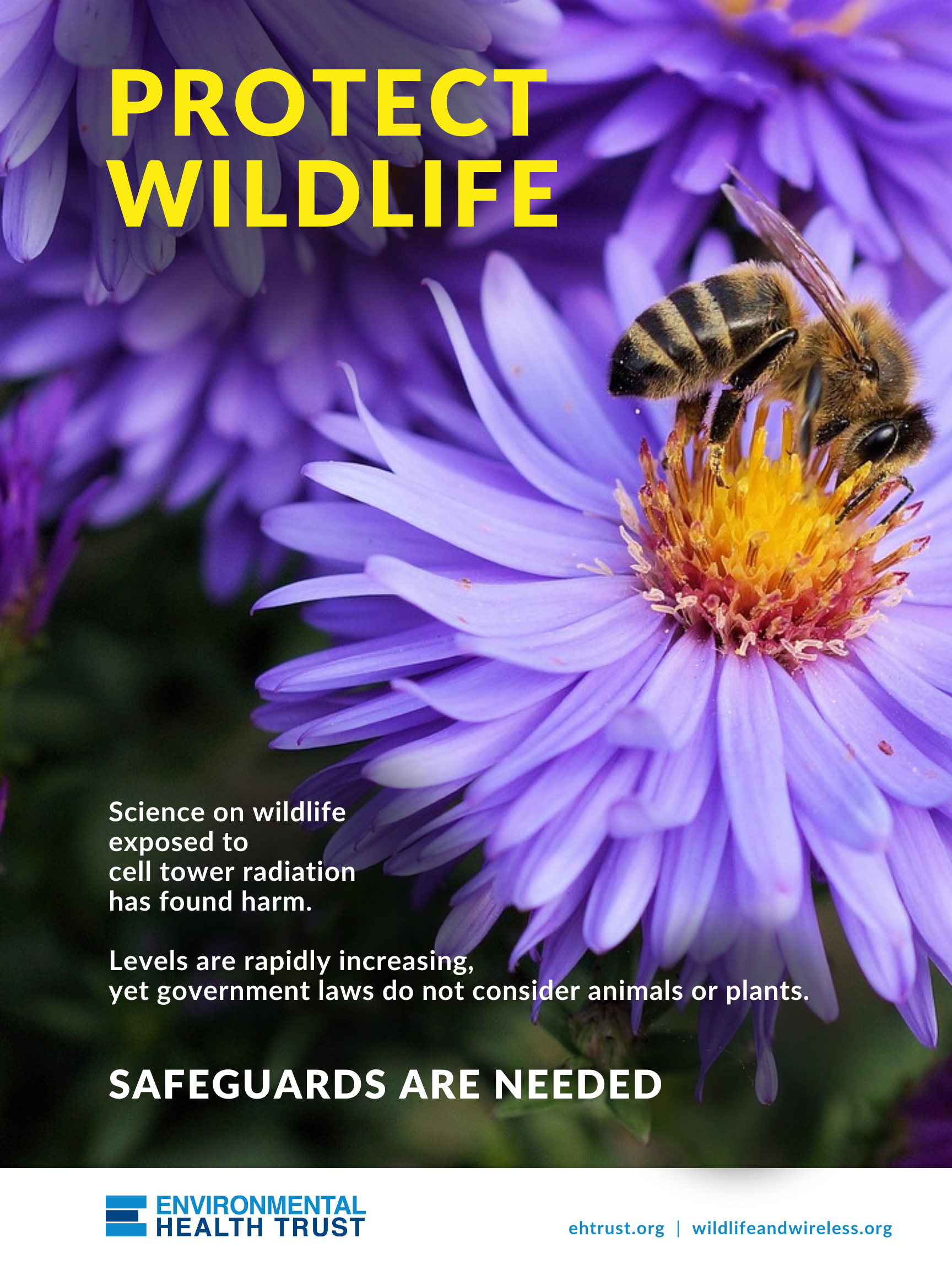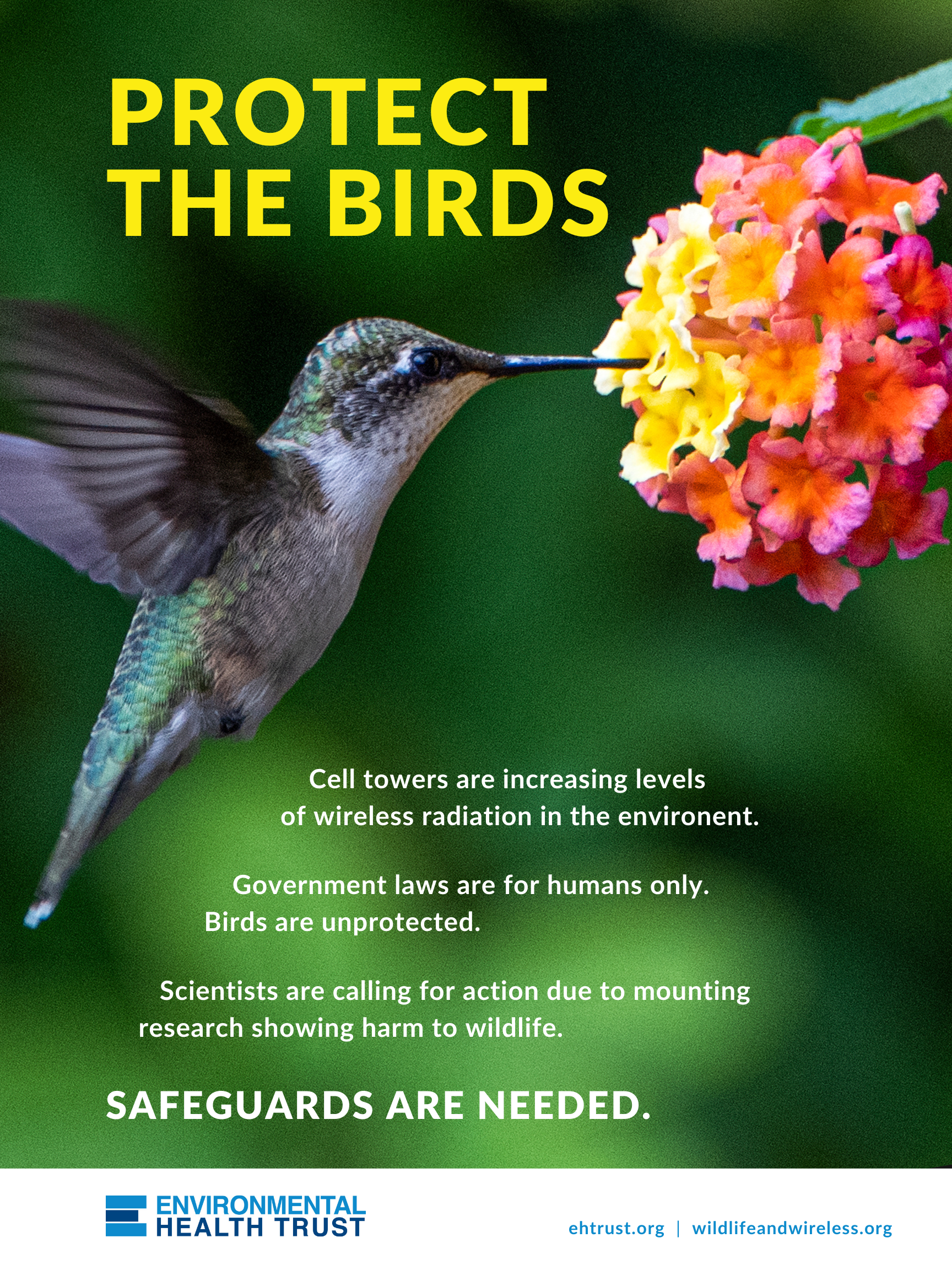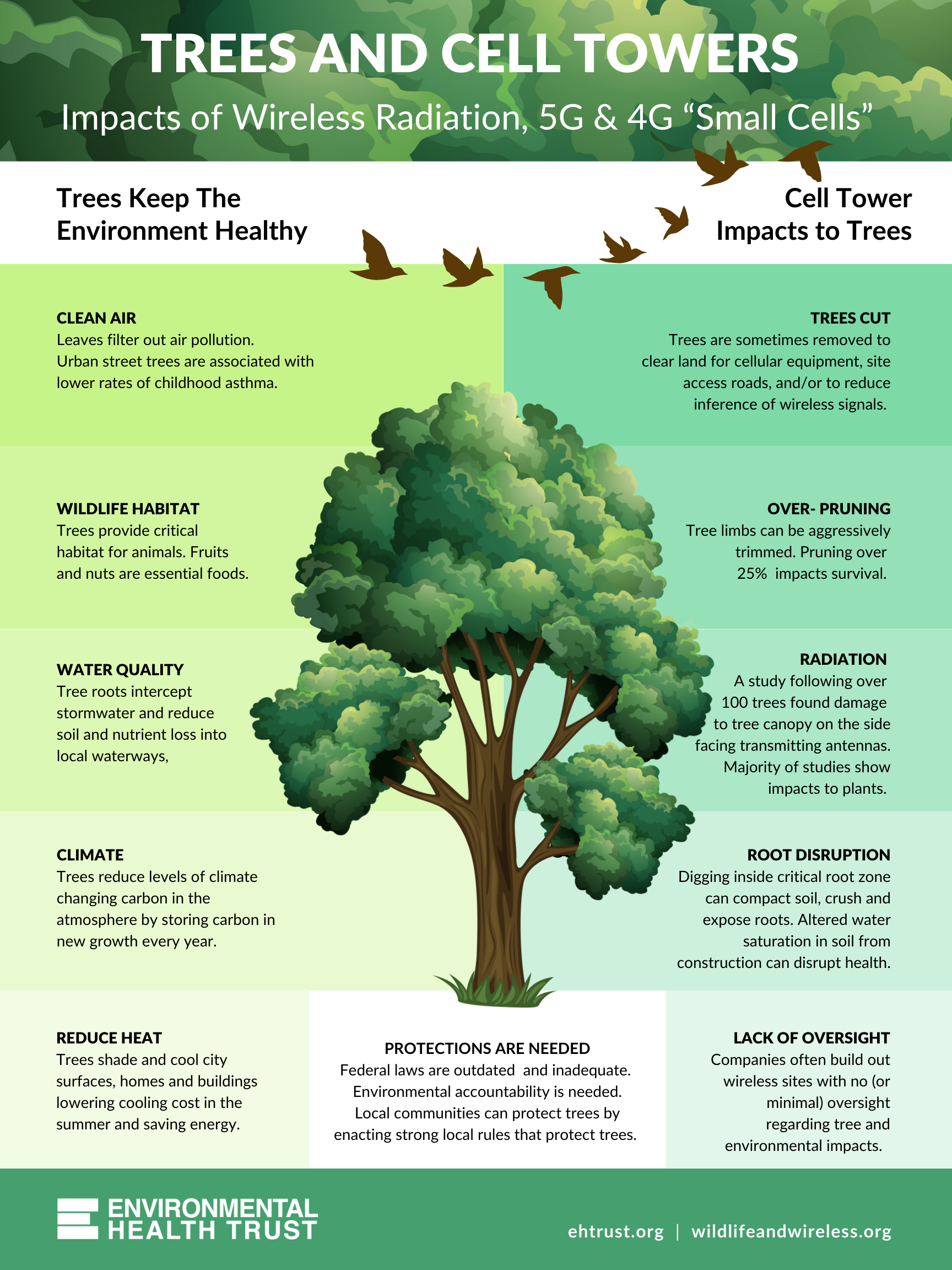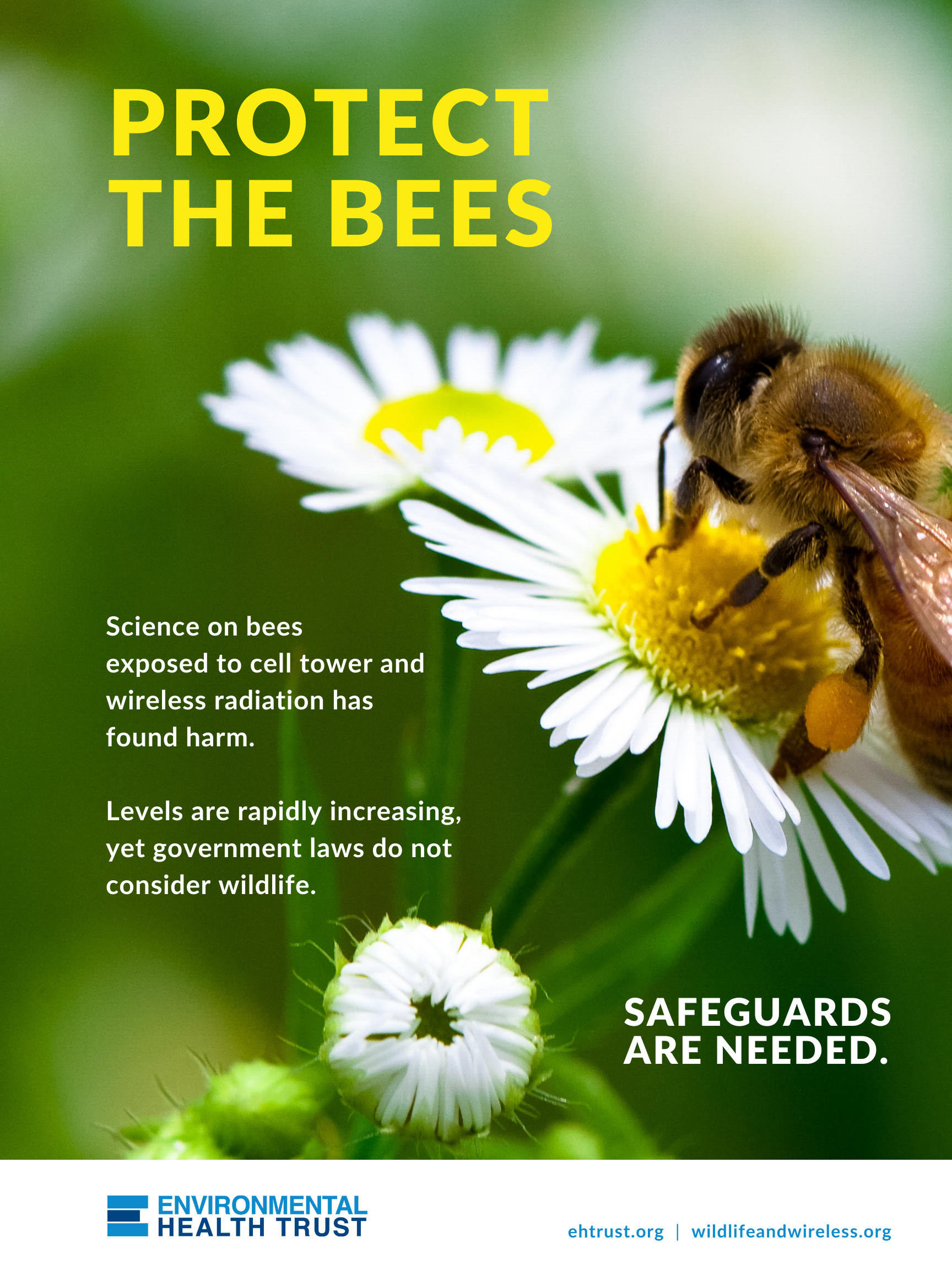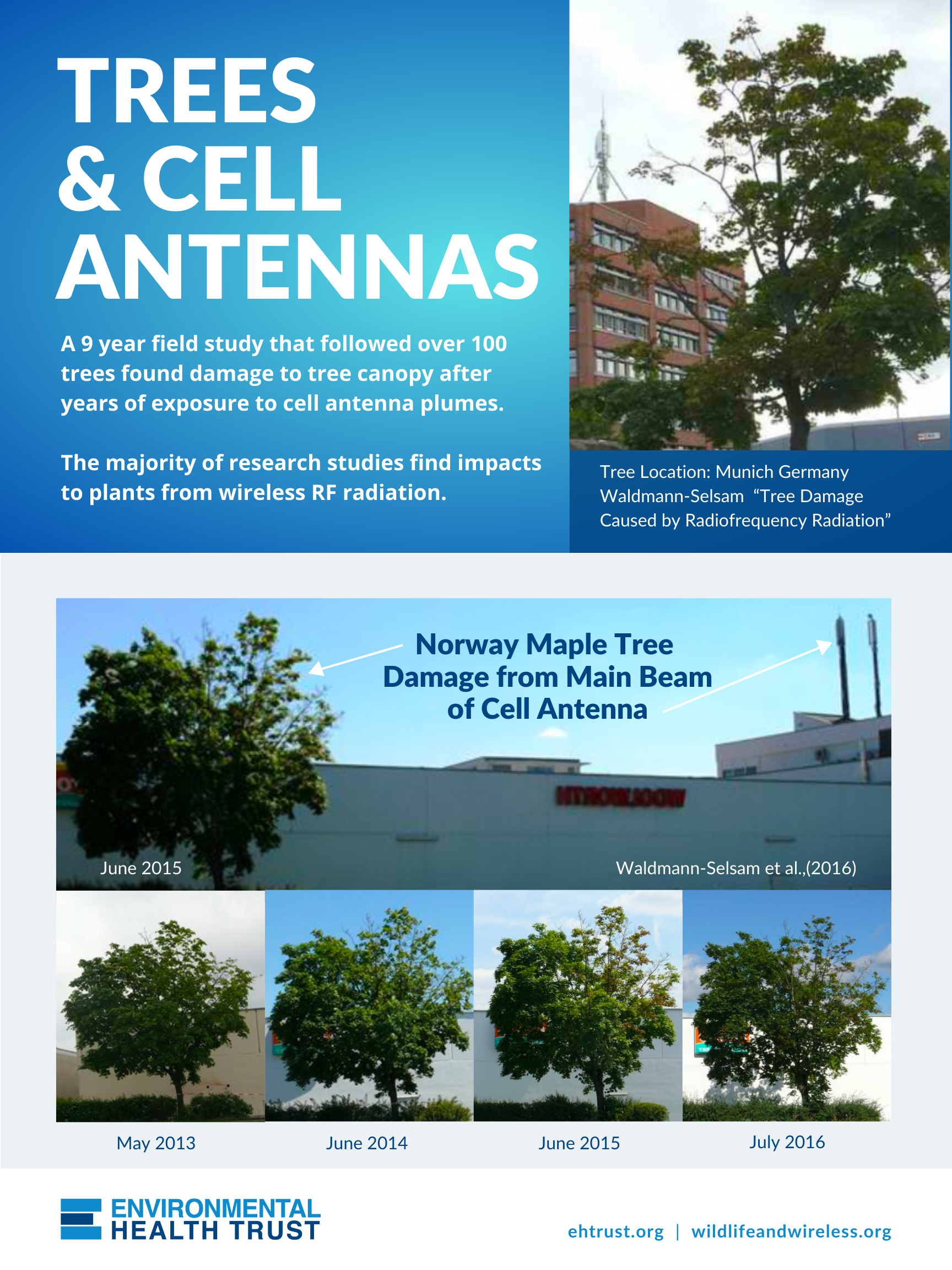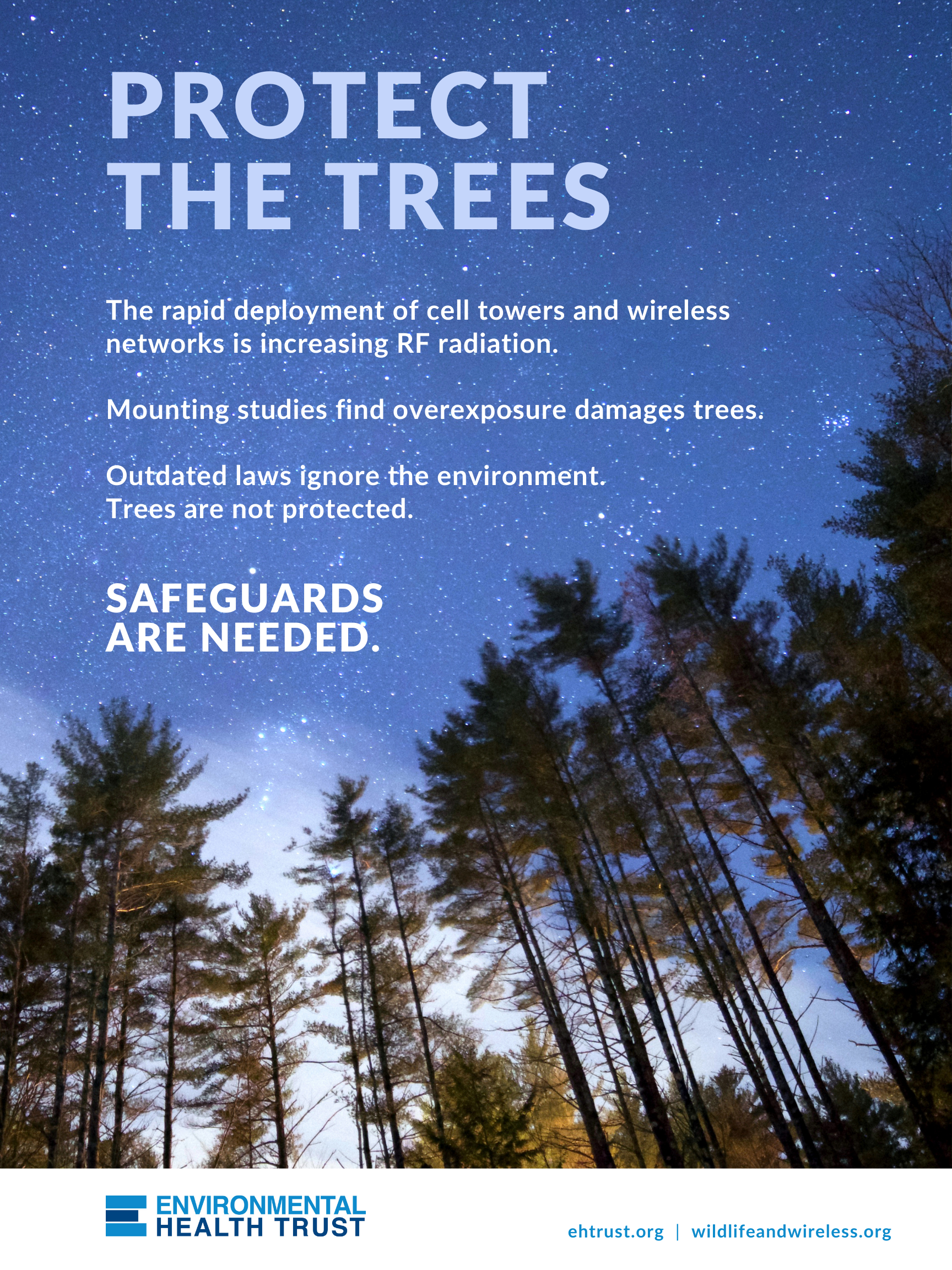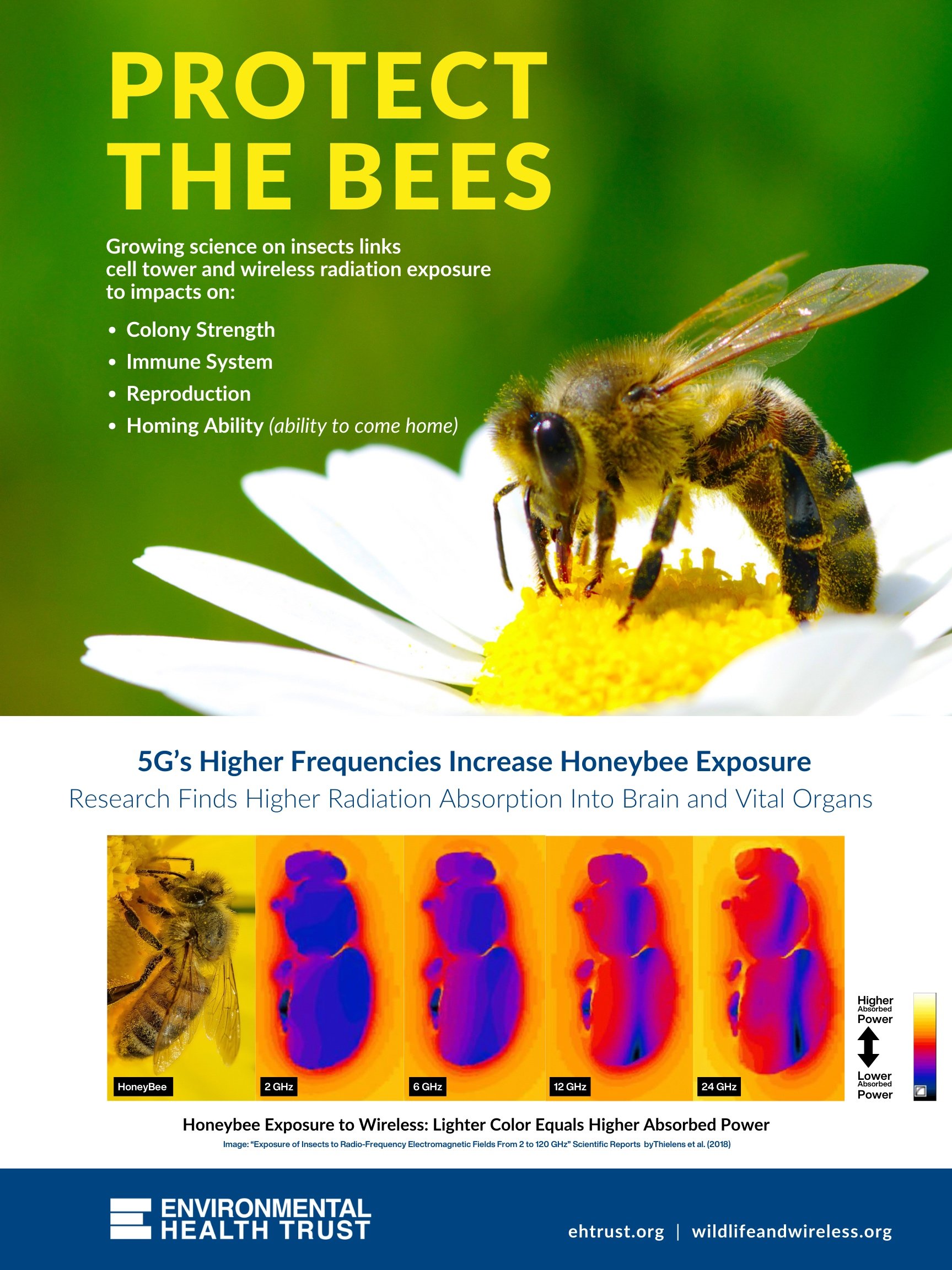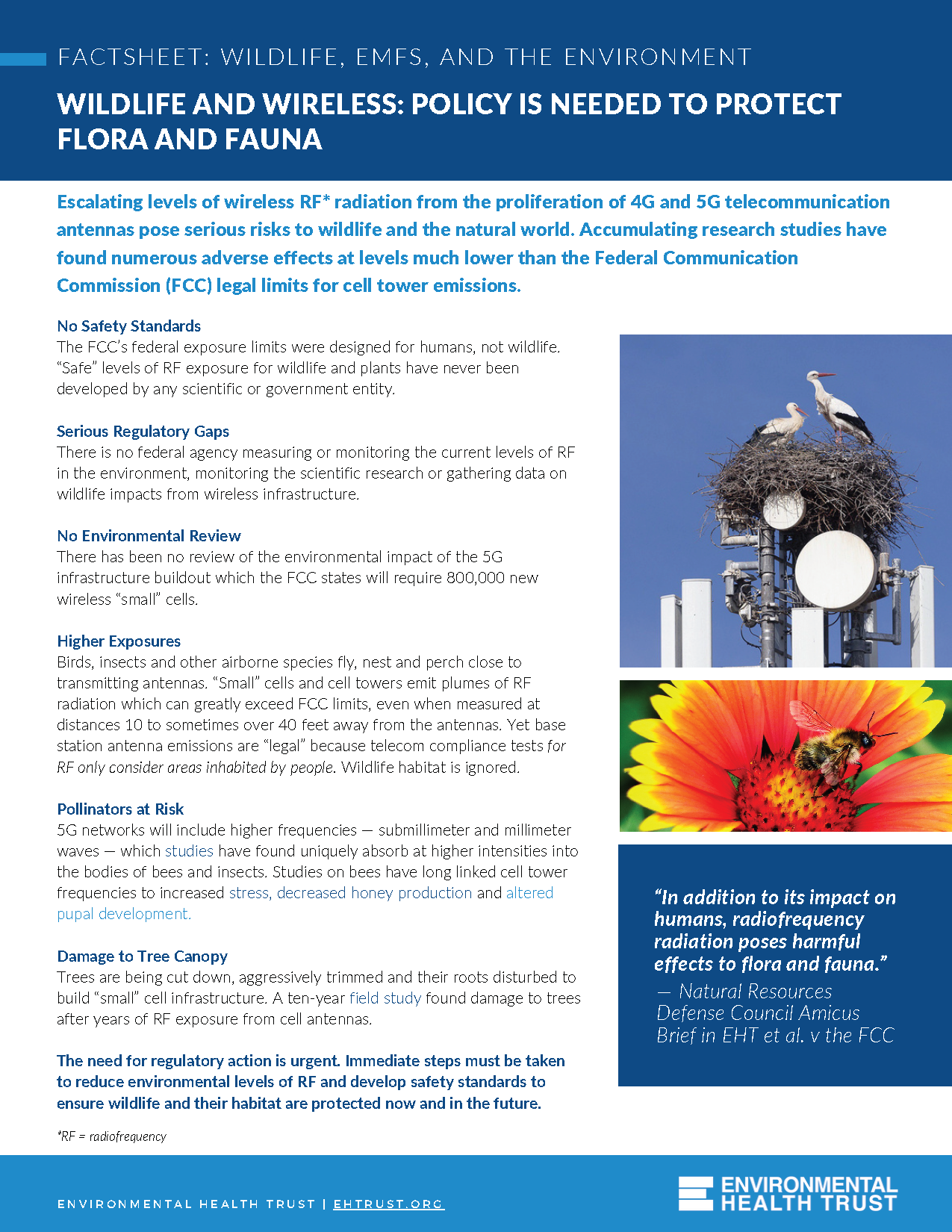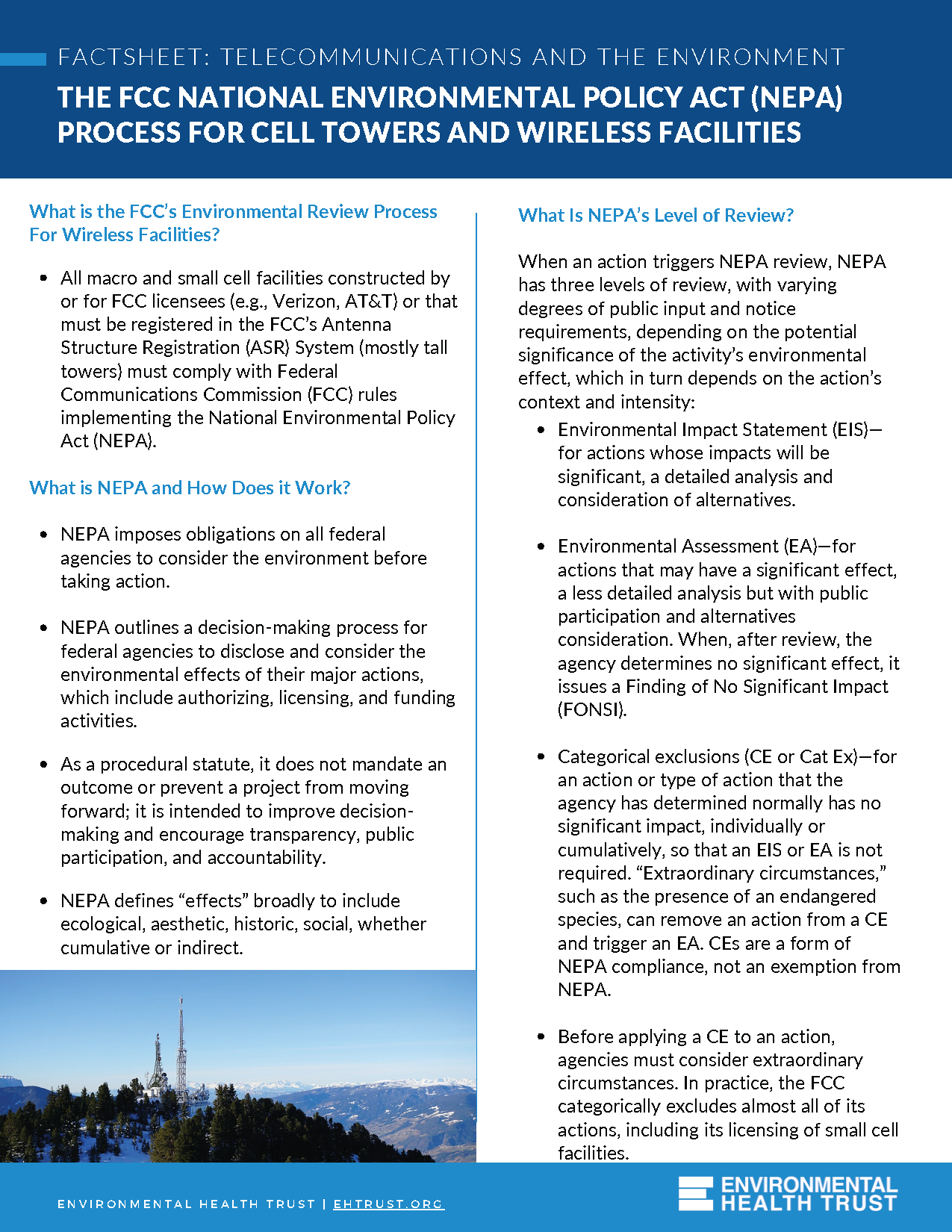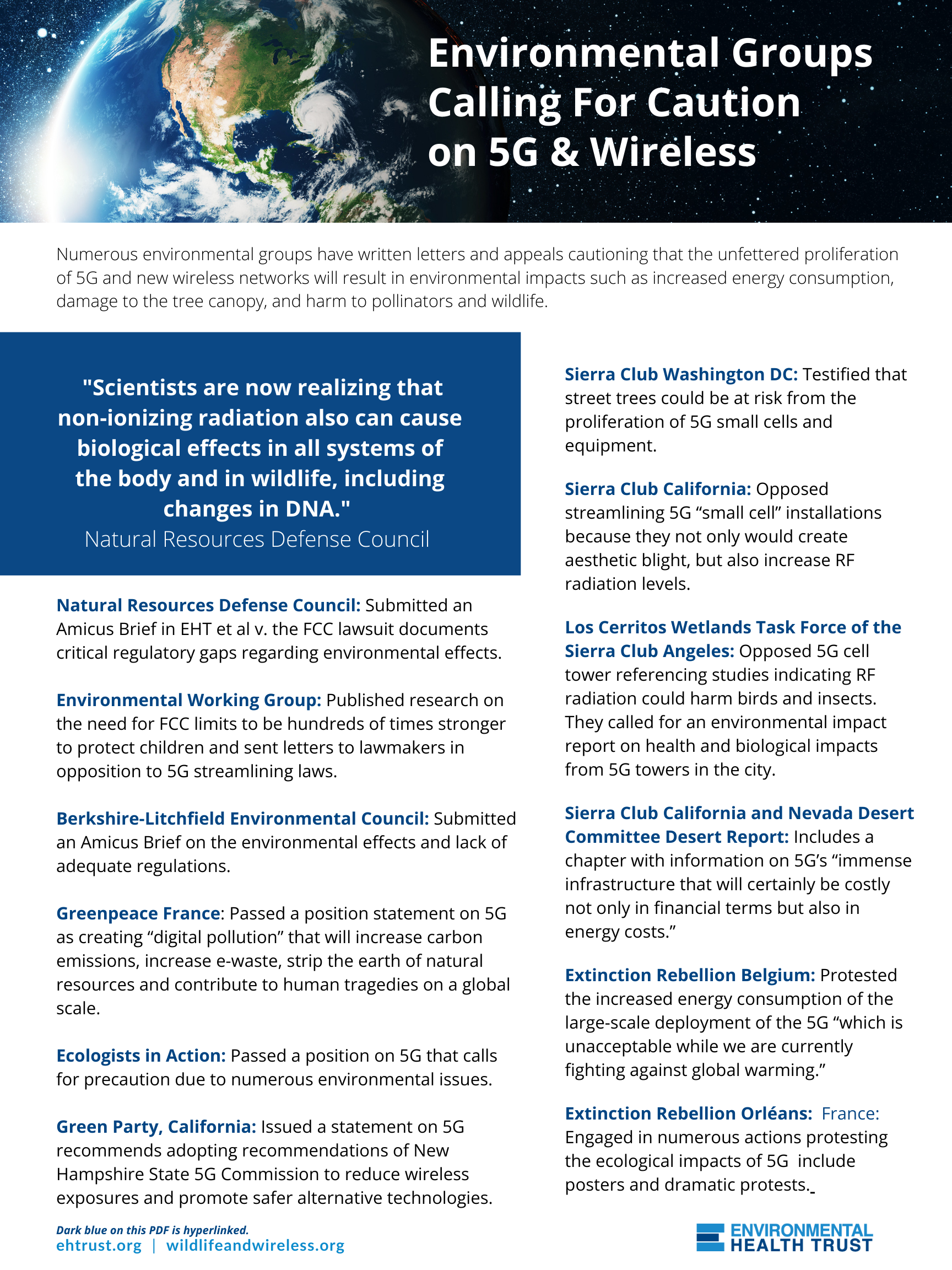Resources

Looking for reliable, up-to-date science based information on wildlife and wireless? Our team of experts has developed key resources you can use to raise awareness and support meaningful change on this issue.
Facts on Wildlife and Wireless
Increasing levels of wireless radiation and human-made electromagnetic fields (EMFs) in our environment pose a serious threat to biodiversity and the health of Earth’s ecosystems.
Bees and other pollinators are uniquely vulnerable.
Visual Resources
We encourage you to utilize our posters, factsheets, and issue briefs to share valuable information on environmental health across various platforms. EHT has created posters for your local farmers market and flyers for your awareness raising door to door campaign. Our factsheets and issue briefs can be shared with your lawmakers as well as local environmental groups.
Posters
Factsheets
Key Studies & Reports
-
Low-level EMF effects on wildlife and plants: What research tells us about an ecosystem approach.
Front. Public Health | November 25, 2022
Focused on the unique physiology of non-human species, their extraordinary sensitivity to wireless and non-ionizing EMF, and the likelihood that artificial EMF is capable at very low intensities of adversely affecting both fauna and flora in all species studied.
-
Electromagnetic radiation as an emerging driver factor for the decline of insects
By Alfonso Balmori | February 5, 2021
Documents the scientific evidence indicating that EMFs are a factor in the decline of global insect biodiversity, especially for crucial pollinators. While farming and pesticides are usual culprits, the study points to non-thermal microwave wireless and EMF radiation as environmental stressors.
-
Review: The effects of non-ionizing electromagnetic fields on flora and fauna
Reviews on Environmental Health | May 27, 2021
This three-part 150-page research review by U.S. experts published in the journal “Reviews on Environmental Health,” analyses over 1,200 peer-reviewed studies finding that birds, insects, and animals are uniquely sensitive to wireless radiation. It identifies low-level wireless as a pollutant.
-
Radiofrequency radiation injures trees around mobile phone base stations
Cornelia Waldmann-Selsam, Alfonso Balmori-de la Puente, Helmut Breunig, & Alfonso Balmori | December 1, 2016
In a decade-long study in Germany, researchers linked unusual tree damage to radiofrequency exposure from mobile phone base stations. Measurements on 60 damaged trees showed significant differences in radiation levels on the damaged side facing a phone mast compared to the opposite side and other tree groups.
-
Review of the ecological effects of radiofrequency electromagnetic fields
Environment International | January, 2013
Reviews 113 studies published in the journal Environment International found RF had a significant effect on birds, insects, other vertebrates, other organisms, and plants in 70% of the studies reviewed with development and reproduction in birds and insects the most strongly affected.
-
Impacts of radio-frequency electromagnetic field (RF-EMF) from cell phone towers and wireless devices on bio-systems and ecosystem
Biology and Medicine | January 6, 2013
Presents the findings of the India Inter-Ministerial Committee to study the effects of RF-EMF radiations on wildlife and concluded that out of the 919 research papers collected on birds, bees, plants, other animals, and humans, 593 showed impacts, 180 showed no impacts, and 196 were inconclusive studies.
-
Anthropogenic radiofrequency electromagnetic fields as an emerging threat to wildlife orientation.
By Alfonso Balmori | June 15, 2015
Published in the journal Science of The Total Environment by wildlife Biologist Alfonso Balmori concludes that wireless frequency fields in the MHz range disrupt insect and bird orientation and interfere with the primary process of magnetoreception.
-
Amicus on FCC and the Environment by the Natural Resources Defense Council (NRDC)
Counsel for Amici Curiae, Natural Resources Defense Council et al. | August 5, 2020
This Amicus Brief in EHT et al v the FCC filed by the environmental organization NRDC provides a history of the US government’s lack of accountability on wireless and the environment stating that “radiofrequency radiation generated by wireless service has biological effects that can harm human health as well as other living creatures in the environment.”
-
How the FCC Disregards Environmental Effects of Wireless, 5G and History Amicus of the Berkshire-Litchfield Environmental Council
Berkshire-Litchfield Environmental Council
Legal filing detailing the decades of failure by the US government to address the environmental effects of wireless radiation. “Numerous effects on wildlife are also seen. Birds suffer disorientation near cell towers. European studies found adverse effects in avian breeding, nesting, and roosting, and documented nest and site abandonment, plumage deterioration, and locomotion problems…”
-
Electrosmog and species conservation
By Alfonso Balmori | October 15, 2014
Reviews the science on animals and plants finding that two-thirds of the studies reported ecological effects. Insects and birds are extremely sensitive to electromagnetic fields.
“Electromagnetic radiation is among the potential pollutants with an ability to affect wildlife adversely. It is, therefore, a new area of inquiry deserving of immediate funding and research.”
-
Environmental Procedures at the FCC: A Case Study in Corporate Capture
Erica Rosenberg | December 12, 2022
Details the numerous ways the FCC has failed to address the environment. She documents how, with little oversight or tracking, the FCC delegates environmental review to industry and fails to vigorously enforce its rules or make Environmental documents, including radio frequency emissions studies, publicly available or readily accessible.
-
Blocking Nature's Vulnerable Calls for Help: The Tenth Circuit Dials into the Telecommunications Act's Federal Environmental Preemption Clause in Santa Fe Alliance v. City of Santa Fe
By Samantha Speiss | October 10, 2022
This law review article published in the Villanova Environmental Law Journal details how U.S. telecommunications law ignores the environment and instead, favors corporate growth.
-
The incidence of electromagnetic pollution on the amphibian decline: Is this an important piece of the puzzle?
By Alfonso Balmori | October 26, 2005
Examines the effects of radiofrequency radiation (RFR) from wireless telecommunications on amphibians. Findings suggest that this electromagnetic pollution may cause deformities and reduce amphibian populations. Since amphibians are dependable bio-indicators, further research into this emerging contamination is crucial.
-
Review: Biological effects of electromagnetic fields on insects
By Alain Thill | August 3, 2020
Analyzes the biological impacts of electromagnetic fields on insects by biologist Alain Thill. 72 of 83 analyzed studies found an effect.
-
Exposure of Insects to Radio-Frequency Electromagnetic Fields from 2 to 120 GHz
Scientific Reports: Volume 8 | March 2, 2018
This article examines how insects are exposed to wireless electromagnetic fields across various frequencies, including upcoming 5G systems up to 120 GHz. Using state-of-the-art computer imaging for insect models, the study analyzed RF power absorption across frequencies.
-
Radio-frequency exposure of the yellow fever mosquito (A. aegypti) from 2 to 240 GHz
Eline De Borre, Wout Joseph,Reza Aminzadeh, Pie Müller, Matthieu N. Boone, Iván Josipovic, Sina Hashemizadeh, Niels Kuster, Sven Kühn, & Arno Thielens | October 28, 2021
The introduction of 5G networks may lead to higher RF electromagnetic field (EMF) absorption into insects, potentially causing dielectric heating. The study on the yellow fever mosquito showed that RF absorption rises with frequency increases, especially between 2-90 GHz, peaking at 90-240 GHz. This increased absorption could affect mosquito behavior, physiology, and distribution.
-
Electromagnetic radiation of mobile telecommunication antennas affects the abundance and composition of wild pollinators
Journal of Insect Conservation | April 2016
The study examined the effects of EMR from telecom antennas on various wild pollinators. It found that EMR generally had negative impacts, reducing the abundance of beetles, wasps, and hoverflies, but increasing certain underground-nesting bees and bee flies. Although butterflies were unaffected, these EMR-induced changes could affect plant diversity, crops, and human welfare by altering pollinator populations and ecosystems.
-
Mobile phone-induced honeybee worker piping
By Daniel Favre | April 13, 2011
Investigates the potential impact of electromagnetic waves emitted by mobile phones on honeybee behavior, highlighting the significant ecological, economic, and political importance of honeybees worldwide. The study involved placing active mobile phone handsets near honeybees and recording and analyzing the sounds produced by the bees.
-
Changes in honeybee behavior and biology under the influence of cell phone radiations
By Sharma VP, Kumar NR | 2010
Examines how mobile phone-emitted electromagnetic waves affect honey bee behavior, given their global ecological and economic significance. The study found that active mobile phones influenced honeybee actions, notably triggering a worker piping signal, which usually indicates colony swarming or disturbance.
-
Exposure to cell phone radiations produces biochemical changes in worker honey bees
Toxicol Int. | January–June 2011
The study examined cell phone radiation's effects on honey bee biomolecules. Bees exposed to radiation showed reduced activity and were drawn towards the radiation source. Initially, there was a spike in biomolecules like proteins, carbohydrates, and lipids, indicating stress. However, with prolonged exposure, these levels dropped, hinting at possible adaptation.
-
Review: Weak radiofrequency radiation exposure from mobile phone radiation on plants
By Malka N. Halgamuge | May 6, 2016
The study examined if weak radiofrequency electromagnetic fields (RF-EMF) from mobile phones affect plants. Analyzing 45 scientific papers from 1996-2016 with 169 experiments, 89.9% reported physiological or morphological changes in plants due to RF-EMF exposure. Plants were particularly responsive to specific frequency ranges, notably 800-1500 MHz, 1500-2400 MHz, and 3500-8000 MHz.
-
Distribution, diversity and abundance of some insects around a telecommunication mast in Ilorin, Kwara State, Nigeria
Bulletin of the National Research Centre: Volume 45 | December 15, 2021
This study analyzed the effects of electromagnetic fields (EMFs) from telecommunication on insects in Ilorin, Nigeria. Focusing on an isolated area with a telecommunication mast, five sampling points around the mast and a control point were chosen. For 22 weeks, EMF levels and insect counts were recorded using acoustimeters and traps.
-
U.S. Fish & Wildlife Service Concerns Over Potential Radiation Impacts of Cellular Communication Towers on Migratory Birds and Other Wildlife – Research Opportunities
By Dr. Albert M. Manville, II | May 10, 2007
Discusses various issues related to the potential impacts of communication towers on wildlife, especially birds and bees. It addresses concerns about the direct mortality of birds due to tower collisions and tower-emitted radiation's potential effects on both bird and bee populations.
-
Report for the United Nations Educational Scientific and Cultural Organization
By Mark Broomhall
The study reveals the negative effects of microwave radiation from communication towers on Australia's Nightcap National Park, a World Heritage site. This radiation disrupts the ecosystem, causing a division in species movement. Towers, including 3G and 4G, emit strong electromagnetic signals, overpowering the subtle frequencies vital for many organisms, leading to wildlife either fleeing or dying.
-
Reduced growth of soybean seedlings after exposure to weak microwave radiation from GSM 900 mobile phone and base station
By Malka N. Halgamuge | January 21, 2015
The study examined the effects of radiation pollution on soybean seedling growth. Seedlings exposed to high amplitude GSM cell phone radiation showed reduced epicotyl growth, while low amplitude had minimal impact. Continuous wave radiation affected root or hypocotyl growth based on amplitude. Extremely low-level GSM radiation boosted root growth but hindered epicotyl and hypocotyl growth.
-
Influence of microwave frequency electromagnetic radiation on terpene emission and content in aromatic plants
J Plant Physiol | September 15, 2014
The study explored the effects of microwave irradiation, from wireless routers (WLAN) and mobile devices (GSM), on parsley, celery, and dill plants. Results showed that irradiation caused structural changes in the plants, like thinner cell walls and smaller chloroplasts, and increased emissions of certain volatile compounds. The effects were more noticeable with WLAN frequencies.
-
The effect of the non-ionizing radiation on cultivated plants of Arabidopsis thaliana (Col.)
Flora: Volume 223 | August 2016
This study assessed the effects of non-ionizing radiation from a cordless DECT system on Arabidopsis thaliana plants. Exposed plants showed reduced biomass, thinner leaves, and fewer chloroplasts compared to controls. Detailed examinations revealed the near disappearance of tiny hair-like structures on leaves and structural changes in the chloroplasts.
-
Adverse Influence of Radio Frequency Background on Trembling Aspen Seedlings: Preliminary Observations
By Katie Haggerty | May 13, 2010
This study addresses the decline of aspen trees in North America, particularly incidents of rapid mortality observed in Colorado since 2004. It highlights the significant changes in the Earth's radio frequency (RF) environment over the past two centuries, largely due to electricity's development and usage in various applications.
-
Impact of Electromagnetic Radiation on Honey Stomach Ultrastructure and the Body Chemical Element Composition of Apis mellifera
By E.A. Mahmoud & A. Gabarty | March 23, 2021
Researchers studied the effects of mobile phone radiation on honey bee foragers' stomach cells. Bees exposed to radiation for 20 minutes had completely decayed stomach cells, while those exposed for 10 minutes showed cell damage and altered chemical compositions. The study indicates that mobile phone radiation harms honey bee stomach cells and advises against using mobile phones near beehives.
-
World is ‘on notice’ as major UN report shows one million species face extinction
United Nation News | May 6, 2019
The UNESCO Global Assessment highlights alarming biodiversity loss, with human activities putting nearly 25% of plant and animal species, or around one million species, at risk of extinction. This rate surpasses the natural average of the past 10 million years. Based on contributions from 400 experts across 50 countries, the report emphasizes biodiversity's role in human well-being and the urgent need for conservation and restoration efforts.
-
Reinventing Wires: The Future of Landlines and Networks
From Reinventing Wires: The Future of Landlines and Networks | February 5, 2018
In this podcast, the discussion centers on the information gap that exists regarding the advantages of wired communications over wireless options like copper cable and optical fiber. The podcast highlights the need for a comprehensive analysis of the costs and benefits associated with both wired and wireless technologies, especially concerning public investment, health impacts, environmental considerations, and energy efficiency.
-
Radiofrequency Electromagnetic Fields Emitted from Mobile Phones and Wi-Fi Router on the Growth Rate and Susceptibility of Enterococcus faecalis to Antibiotics.
Journal of Biomedical Physics and Engineering: Volume 12, Issue 4 | July–August 2022
In the past decade, increased radiation exposure from smartphones and Wi-Fi routers has sparked concerns. A study examined the impact of this radiation on Enterococcus faecalis, commonly found in tooth root canals. After 6 hours of exposure, the bacteria became less sensitive to antibiotics, but longer exposure (e.g., 24 hours) made them more sensitive.
-
Antibacterial Susceptibility Pattern of the Pseudomonas aeruginosa and Staphylococcus aureus after Exposure to Electromagnetic Waves Emitted from Mobile Phone Simulator.
Journal of Biomedical Physics and Engineering: Volume 9, Issue 6 | November–December 2019
The widespread use of Wi-Fi modems and mobile phones has raised concerns about their impact on microorganisms and human health due to electromagnetic waves. This study investigated the effect of prolonged exposure to 900 MHz waves from a mobile phone simulator on Staphylococcus aureus and Pseudomonas aeruginosa bacteria
-
Evaluation of Wi-Fi Radiation Effects on Antibiotic Susceptibility, Metabolic Activity and Biofilm Formation by Escherichia Coli 0157H7, Staphylococcus Aureus and Staphylococcus Epidermis.
Journal of Biomedical Physics and Engineering: Volume 9, Issue 5 | September–October 2019
This study investigated the impact of Wi-Fi radiation, an electromagnetic field (EMF), on harmful bacteria strains like Escherichia coli 0157H7, Staphylococcus aureus, and Staphylococcus epidermis.
-
A demonstration of athermal effects of continuous microwave irradiation on the growth and antibiotic sensitivity of Pseudomonas aeruginosa PAO1
Biotechnology Progress: Volume 33, Issue 1 | October 28, 2016
This study illuminated that exposing pseudomonas aeruginosa bacteria to microwaves at a constant 37°C temperature initially showed no growth reduction for the first 6 hours. However, after 12 hours, there was a significant shift in growth pattern, indicating the formation of persister cells triggered by microwaves.
-
The Effect of Electromagnetic Radiation Transmitted from Routers on Antibiotic Susceptibility of Bacterial Pathogens.
Journal of Biomedical Physics and Engineering: Volume 12, Issue 4 | July–August 2022
This study investigated the influence of non-ionizing radiofrequency radiation from Wi-Fi routers on bacterial strains and their antibiotic response. They exposed some bacteria to this radiation while keeping others as controls. Antibiotic disks were applied, and inhibition zones were tracked.
-
Evaluation of the Effect of Radiofrequency Radiation Emitted From Wi-Fi Router and Mobile Phone Simulator on the Antibacterial Susceptibility of Pathogenic Bacteria Listeria monocytogenes and Escherichia coli
Dose-Response: Volume 15, Issue 1 | January 23, 2017
This study examined how radiofrequency electromagnetic fields (RF-EMF) from mobile phones and Wi-Fi routers affect microorganisms' antibiotic susceptibility. It revealed that exposure to RF-EMFs made Listeria monocytogenes and Escherichia coli more antibiotic-resistant at a certain radiation level.
The Published Science
See a reference list of the peer reviewed published science on wireless and EMF impacts to birds bees and trees at this link.
Videos
Wildlife Is Impacted by Wireless Radiation
Watch an animated video that explains the science and regulatory issues of wireless radiation.
Wireless Impacts Honeybees
Watch an interview with a scientist who found wireless radiation impacts honeybee behavior. This is from the documentary “Something in the Air” on wireless health and environment.
Tadpole Development Impacted by Cell Tower Radiation
Starling Childs presents a brief summary of the research on electromagnetic radiation birds as well as research showing tadpoles impacted by cell tower radiation. The study is entitled “Mobile phone mast effects on common frog (Rana temporaria) tadpoles: the city turned into a laboratory.”
Wireless Environmental Impacts
This video explainer is from the scientific website wirelessenviroimpacts.science documenting the scientific evidence supporting wireless radiation to be included in the United Nation Convention on Biological Diversity.
Wildlife, Wireless, EMFs and Environment : Expert Webinar
Several experts in law, science and policy present on environmental health impacts of wireless proliferation. This is a scientific and technical presentation of the Environmental Health Trust.. co-authors of a landmark three-part review, “Effects of no
5G Cell Towers, Trees, Climate, Birds, Bees and Trees: Presentation to Marin County California
A public presentation on environmental impacts of 5G, cell towers and small cells on the potential effects on trees, climate, birds, and bees by Theodora Scarato, Executive Director Emerita of Environmental Health Trust.
Wireless Radiation Effects on Wildlife and their Habitats
Albert M. Manville II PhD, is former U.S. Fish and Wildlife lead wildlife biologist on cell tower impacts to wildlife. Manville is a member of the International Commission on the Biological Effects of Electromagnetic Fields.
Join The Campaign
Now is the time for science-based policy that protects our wildlife

